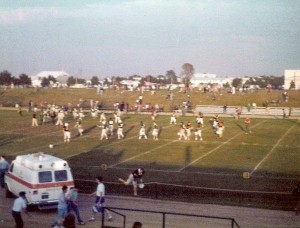Misawa AB, late fall, 1977. If it were later in the year, the field would have been under about four feet of snow. I think I took this picture because some of the FEN-Misawa staff were playing. They would have been for one of the larger unit teams – FEN wasn’t large enough to field a team of our own.
 Sgt. Mom
Sgt. Mom
Putting on the Dog
Short Bus Hot Dogs, photographed two years ago, at the Abilene Balloon Festival.
The Great Texas Pig War of 1841
(Another in my historical trivia posts – this is a cross-post from my book-blog. The Pig War features in my latest book, Deep in the Heart … along with a lot of other relatively unknown mid-19th century trivia.)
The Pig War was not actually an honest-to-pete real shooting war. But it did involve a pair of international powers; the Republic of Texas, and the constitutional monarchy of France. And thereby hangs the story of a neighborhood squabble between a frontier innkeeper and a gentleman-dandy named Jean Pierre Isidore Dubois de Saligny who called himself the Comte de Saligny. He was the charge d’affaires, the representative of France to the Republic of Texas, arriving from a previous assignment the French Legation in Washington D.C. He had been instrumental in recommending that France extend diplomatic recognition to the Republic of Texas, but one might be forgiven for thinking that some kind of 19th Century Peter Principle was at play . . . for Dubois turned out to be terribly undiplomatic.
Frontier Surgeon or Ferdinand and Hermann’s Excellent Frontier Adventure
The practice of medicine in these United (and for the period 1861-1865, somewhat disunited) States was for most of the 19th century a pretty hit or miss proposition, both in practice and by training. That many sensible people possessed pretty extensive kits of medicines – the modern equivalents of which are administered as prescriptions or under the care of a licensed medical professional – might tend to indicate that the qualifications required to hang out a shingle and practice medicine were so sketchy as to be well within the grasp of any intelligent and well-read amateur, and that many a citizen was of the opinion that they couldn’t possibly do any worse with a D-I-Y approach. Such was the truly dreadful state of affairs generally when it came to medicine in most places and in all but the last quarter of the 19th century they may have been better off having a go on their own at that.
Most doctors trained as apprentices to a doctor with a current practice. There were some formal schools of medicine in the United States, but their output did not exactly dazzle with brilliance. Successful surgeons of the time possessed two basic skill sets; speed and a couple of strong assistants to hold the patient down, until he was done cutting and stitching. Most of the truly skilled doctors and surgeons had their training somewhere else – like Europe.
But in San Antonio, from 1850 on – there was a doctor-surgeon in practice, who ventured upon such daring medical remedies as to make him a legend. His patients traveled sometimes hundreds of miles to take advantage of his skill …


